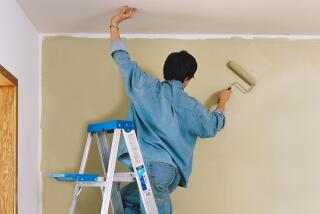Swedish Product May Be Solution to Cracks
Most homes undergo a “settling” period as foundations shift and readjust to soil changes or minor earth tremors, causing unsightly cracks to appear. Invariably, in our experience, this happens when the house has just been repainted.
For those who know that feeling of frustration, take heart. A new product recently introduced to the American marketplace from Scandinavia may help solve that problem.
It is an innovative and cost-efficient wall and ceiling covering that doesn’t shrink or stretch and is resistant to all sorts of things. The product is called FibreWall and is a special glass material from which fibers of different lengths are drawn at a temperature of 1,400 centigrade, and woven into an attractive and durable fire-resistant covering.
By being totally inorganic, the substance also resists mildew and solvents and contains no toxic substances. Its stable nature helps to reinforce the wall or ceiling surfaces and prevents new cracks from developing.
We tried the covering on the ceilings of a living room and hallways of a 1937-vintage home that had long-standing cracks, camouflaged over the years with cloth strips that had been suggested for that type of repair. The results with the new product were far superior.
FibreWall comes in several patterns (twill and herringbone) and in smooth or coarse weaves and is sold in bolts, which are 39 1/2 inches wide and in excess of 164 feet long. They are priced from $200 to $400 per roll (or 37 to 74 cents per square foot). Each bolt provides 540 square feet of material or the equivalent of 18 to 20 domestic rolls.
On recommendation of the FibreWall representative, Nils Angert, we used a flat latex paint over the FibreWall material and it absorbed well into the weave, with the added benefit that it also became peel-proof when integrated into the textured surface.
FibreWall has been in use in Sweden, where it is manufactured, and other European countries for decades and its popularity is widespread. Angert said he had had the same FibreWall covering in his Stockholm office for 22 years. The fiberglass covering also has been used extensively in hospitals, commercial and office buildings. Caltech and St. Joseph’s Hospital are among those now using the product in the Southland.
In new construction, it can be applied directly over concrete, rough cast walls or gypsum wallboard. Its application is a simple procedure.
Before starting, the wall or ceiling surface must be dry and larger cracks and joints should be smoothed out with a patching material. Also, if the surface in question seems unduly porous, a prime coat is required.
By means of a lambs-wool roller, a quality wallpaper adhesive is then spread uniformly to an area equivalent to two fabric widths, avoiding about four inches at either end to allow for exact fitting and cutting of the fabric while still in a dry state.
The pre-cut fabric is then placed on the adhesive, edge to edge, and a spatula is run over the surface to remove any air bubbles. Trimming with a sharp blade and steel ruler around the edges and doors and windows should be done immediately after the fabric has been positioned.
Areas covered by FibreWall should be allowed to dry thoroughly before painting; two coats applied richly and evenly give the best results. The recommended adhesive is Shur-Stick 111 by Gibson-Homans.
Further information on the FibreWall product may be obtained through Nils Angert, Regal of Scandinavia, 433 S. Spring St., Los Angeles 90013.
More to Read
Inside the business of entertainment
The Wide Shot brings you news, analysis and insights on everything from streaming wars to production — and what it all means for the future.
You may occasionally receive promotional content from the Los Angeles Times.










